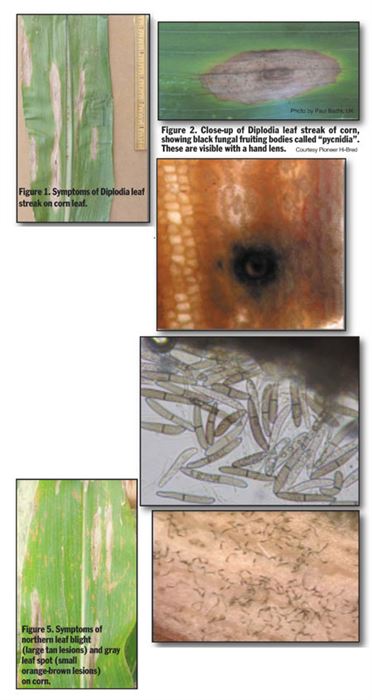Diplodia Leaf Streak Of Corn Growing In Importance In Kentucky
LEXINGTON, KY.
Diplodia leaf streak of
corn is appears to be
growing in importance in
Kentucky and the Midwest.
This disease is caused by the
f u n - g u s
S t e n o -
c a r p e l l a
macrospora.
Symptoms of Diplodia leaf
streak often appear as oval
or cigar-shaped tan lesions
on leaves (Figure 1). These
lesions appear very similar
to those caused by northern
leaf blight (Figure 5). However,
it is easy to distinguish
these two diseases in the
field using a hand lens.
Stenocarpella macrospora
produces very tiny, black
fruiting bodies in diseased
tissues (Figures 2-4). In
order to use a hand lens
properly, place the lens very close to
one’s eye, so as to get the best possible
view. If you do this, you can see the
black fruiting bodies of Stenocarpella
macrospora. In contrast, spores of the
northern leaf blight fungus are produced
directly on the dead leaf tissue,
rather than in fruiting bodies. This
sporulation gives the northern leaf
blight lesions a grayish-green, fuzzy
appearance to the naked eye (Figure
5). Furthermore, upon inspection with
a hand lens, northern leaf blight
sporulation has the look of 3-5 day-old
whiskers on the face of an unshaven
man (Figure 6). Northern leaf blight
sporulation is therefore very distinct
from the look of the tiny, black fruiting
bodies of Stenocarpella macrospora
(Figure 2). Of course, you can always
have suspect cases evaluated
through the UK plant
diagnostic laboratories by
contacting your county Extension
agent.
Stenocarpella mac-rospora
can attack not only the
leaves, but it can also cause
stalk rot and ear rot. Stenocarpella
macrospora is related
to, but distinct from,
Stenocarpella maydis. Stenocarpella
maydis is by far the
most common cause of
Diplodia ear rot and Diplodia
stalk rot in Kentucky.
However, for several years
now we have been on the
watch for Stenocarpella
macrospora causing stalk
rot and ear rot in Kentucky.
Stenocarpella macrospora survives in infested
corn residue, just like Stenocarpella maydis.
Therefore, where this disease is present, crop
rotation will help to reduce disease risk. To my
knowledge, no fungicides are labeled for control
of this disease.
Diplodia leaf streak is certainly a disease to be
on the watch for, especially since it can
attack
not only the leaves, but also the stalk
and the ear. Δ
DR. PAUL VINCELLI: Extension Plant
Pathologist, University of Kentucky
